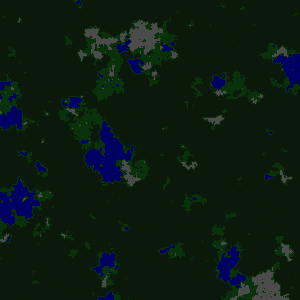Procedural 2D worldmap generator. It can generate maps defined at material structure that allow you to create different biomes.
Generated map with grass, forest, water, sand and mountains
Increased amount of water (ocean biome)
Increased amount of forests (forest biome)
Increased amount of sand and with cactis (desert biome)
npm install --save worldmap-generator
You can find usage example at /examples/example.js.
Simple usage is:
var WorldmapGenerator = require('worldmap-generator');
// create world with some params
var world = new WorldmapGenerator({
size: {
width: 300, // map width
height: 300 // map height
},
tileTypes: [
{
name: 'grass', // tile name
connections: {'grass': 500, 'forest': 1, 'mountain': 1, 'sand': 1} // connections to surrounding tiles with its frequencies
// frequency is used for calculating probabillity of appearence next to this tile
},
{
name: 'forest',
connections: {'grass': 1, 'forest': 300}
},
{
name: 'mountain',
connections: {'grass': 1, 'mountain': 150}
},
{
name: 'water',
connections: {'water': 500, 'sand': 1}
},
{
name: 'sand',
connections: {'grass': 1, 'water': 1, 'sand': 50}
}
]
});
world.generate(); // generate mapAfter executing world.generate() you can find your map at world.map.
params must contain size and tileTypes elements:
params.size (sizes of world to generate):
- height
- width
params.tileTypes (types and it's connections to each other):
- name - tile type name (will written to map cells)
- connections - connections to other tiles around
All connections must be defined with format where key is a tile type name and value is connection frequency (how often connection tile will be appeared next to this tile):
{'grass': 500, 'water': 0, 'forest': 1, 'mountain': 1, 'sand': 1}In this example grass tile can be connected with high probability, forest/mountain/sand with low probability and water can't connect to this tile at all.
If connection type isn't set in connections object its frequency will be set as 0.
You can find some biome examples at /examples/biomes folder.
- desert.js
- forest.js
- ocean.js




